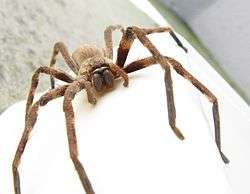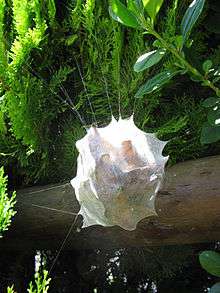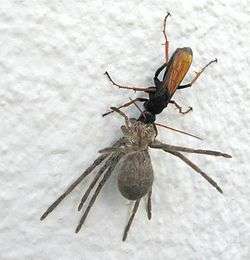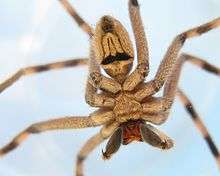Palystes
| Palystes | |
|---|---|
 | |
| Female Palystes castaneus near Somerset West, South Africa | |
| Scientific classification | |
| Kingdom: | Animalia |
| Phylum: | Arthropoda |
| Class: | Arachnida |
| Order: | Araneae |
| Section: | Entelegynae |
| Family: | Sparassidae |
| Genus: | Palystes L. Koch, 1875 |
| Type species | |
| Palystes castaneus Latreille, 1819 | |
| Species | |
|
See text. | |
| Diversity[1] | |
| 22 species | |
Palystes is a genus of huntsman spiders, commonly called rain spiders or lizard-eating spiders,[2] occurring in Africa, India, Australia, and the Pacific.[1] The most common and widespread species is P. superciliosus, found in South Africa, home to 12 species in the genus.[1][2] The name Palystes is derived from either the Latin palaestes or the Greek palaistes, meaning "wrestler".[2] The genus was first described by Ludwig Carl Christian Koch in 1875.[1]
Build
Palystes are large spiders, with a body length of 15–36 mm, and a leg span of up to 110 mm. Their top side is covered in tan to dark tan velvety setae (hairs). The underside of their legs is banded in colour, and their legs and abdomens may be interspersed with slightly longer setae. They have a large moustachial stripe below their front eyes, and extending down their fangs.[2]
Habits
While Palystes mostly hunt insects on plants, they commonly enter houses before rain, or during the summer, where they will prey on geckos (usually Afrogecko porphyreus in the Western Cape, or Lygodactylus capensis in the eastern parts of southern Africa). Males are regularly seen from August to December, probably looking for females.[2]

The large round egg sacs of P. castaneus and P. superciliosus are commonly seen from about November to April. After mating in the early summer, the female makes a 60–100 mm sac out of silk, with twigs and leaves woven into it. She constructs the sac over 3–5 hours, then aggressively guards it until the spiderlings, who hatch inside the protective sac, chew their way out about three weeks later. Females will construct about three of these egg sacs over their two-year lives. Many gardeners are bitten by protective Palystes mothers during this period.[2]
Venom
The size of Palystes spiders, combined with the banding on the underside of the legs exposed when the spider is in threat pose, give them a fearsome appearance.[2][3] An experiment was done in 1959 where a P. superciliosus was allowed to bite an adult guinea pig on the nose. The guinea pig died within 7 minutes, leading to a belief that the spider's venom was dangerous. However, further research on anaesthetized guinea pigs showed that the original guinea pig had actually died of shock, rather than as a result of the spider's venom.[3] In humans a Palystes bite is no more dangerous than a bee sting.[2] It causes a burning sensation, and swelling which lasts for a few days. Recovery is spontaneous and complete.[3]

Wasps
Palystes spiders are also commonly seen paralysed, being dragged by a large wasp called a Pompilid wasp. Sometimes the wasp will not be present. Pompilid wasps only hunt spiders, which they paralyse by stinging them. They then drag the spider back to their nest where they lay an egg on the spider, then seal the spider and the egg in. When the egg hatches, the larva eats the paralysed spider, keeping the spider alive as long as possible by eating peripheral flesh first, and saving the vital organs till last. By doing this, the spider stays fresh long enough for the wasp larva to mature and pupate.[2] The Pompilid wasp species Tachypompilus ignitus is at least largely a specialist hunter of mature Palystes females.[4]
Species
According to The World Spider Catalog, Version 12.5:[1]
- Palystes ansiedippenaarae Croeser, 1996 — South Africa
- Palystes castaneus Latreille, 1819 — South Africa
- Palystes convexus Strand, 1907 — Madagascar
- Palystes crawshayi Pocock, 1902 — Lesotho
- Palystes ellioti Pocock, 1896 — Central, East Africa
- Palystes flavidus Simon, 1897 — India
- Palystes fornasinii Pavesi, 1881 — Mozambique
- Palystes hoehneli Simon, 1890 — Kenya, Tanzania
- Palystes johnstoni Pocock, 1896 — Botswana, Zimbabwe, Malawi, Mozambique, Uganda
- Palystes karooensis Croeser, 1996 — South Africa
- Palystes kreutzmanni Jäger & Kunz, 2010 — South Africa[5]
- Palystes leppanae Pocock, 1902 — South Africa
- Palystes leroyorum Croeser, 1996 — South Africa
- Palystes lunatus Pocock, 1896 — South Africa
- Palystes martinfilmeri Croeser, 1996 — South Africa
- Palystes perornatus Pocock, 1900 — South Africa
- Palystes pinnotheres Walckenaer, 1805 — New South Wales, New Caledonia
- Palystes reticulatus Rainbow, 1899 — Santa Cruz Islands
- Palystes spiralis Strand, 1907 — Madagascar
- Palystes stilleri Croeser, 1996 — South Africa
- Palystes stuarti Croeser, 1996 — South Africa
- Palystes superciliosus L. Koch, 1875 — Southern Africa
Gallery
 Female P. superciliosus
Female P. superciliosus Underside of female P. superciliosus, showing banding
Underside of female P. superciliosus, showing banding Underside of male P. superciliosus
Underside of male P. superciliosus Female P. superciliosus
Female P. superciliosus Female P. castaneus
Female P. castaneus Female P. castaneus
Female P. castaneus Female P. castaneus
Female P. castaneus
References
- 1 2 3 4 5 Platnick, Norman I. (10 December 2011). "Fam. Sparassidae". The World Spider Catalog, Version 12.5. New York, NY, USA: American Museum of Natural History. doi:10.5531/db.iz.0001. Retrieved 19 April 2012.
- 1 2 3 4 5 6 7 8 9 Larsen, Norman. "Palystes (rain spiders, lizard-eating spiders)". Biodiversity Explorer. Cape Town, South Africa: Iziko museums. Retrieved 19 April 2012.
- 1 2 3 Snyman, C.; Larsen, N. (March–April 2005). "Spider bite and its treatment in southern Africa" (PDF). Occupational Health Southern Africa. Kloof, South Africa: Technique Publishing. 11 (2): 22–26. ISSN 1024-6274. OCLC 80013902. Retrieved 19 April 2012.
- ↑ Picker, Mike; Griffiths, Charles; Weaving, Alan (2004). Field Guide to Insects of South Africa (Updated ed.). Cape Town, South Africa: Struik. p. 402. ISBN 978-1-77007-061-5. OCLC 56338396.
- ↑ Jäger, P. and D. Kunz. (2010). Palystes kreutzmanni sp. n. – a new huntsman spider species from fynbos vegetation in Western Cape Province, South Africa (Araneae, Sparassidae, Palystinae). ZooKeys 67 1-9.
External links
- Palystes (rain spiders, lizard-eating spiders) on Iziko Museums' Biodivesity Explorer
| Wikimedia Commons has media related to Palystes. |